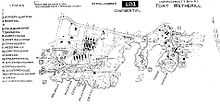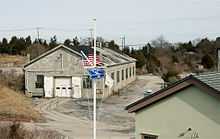Fort Wetherill
|
Fort Dumpling Site | |
 | |
 | |
| Location | 3 Fort Wetherill Road Jamestown, Rhode Island |
|---|---|
| Coordinates | 41°28′38″N 71°21′28″W / 41.477325°N 71.35783°WCoordinates: 41°28′38″N 71°21′28″W / 41.477325°N 71.35783°W |
| Built | 1899 - 1903 |
| Governing body | Rhode Island Department of Environmental Management |
| NRHP Reference # |
72000021 [1] |
| Added to NRHP | March 16, 1972 |
| Fort Wetherill | |
|---|---|
| Jamestown, Rhode Island | |
| Type | Coast Artillery Post |
| Site information | |
| Controlled by | United States |
| Site history | |
| Built | c. 1800; 1941 |
| In use | 1800-1945 |
| Materials | reinforced concrete |
| Garrison information | |
| Past commanders |
Col. Earl C. Webster |
Fort Wetherill is a former Coast Artillery fort that occupies the southern portion of the eastern tip of Conanicut Island, located in Jamestown, Rhode Island. The fort sits atop high granite cliffs, overlooking the entrance to Narragansett Bay. Fort Dumpling, dating from the Revolutionary War, used to occupy a small site within Fort Wetherill. The fort was deactivated and turned over to the State of Rhode Island after World War II and is now operated as Fort Wetherill State Park, a 51-acre (210,000 m2) reservation. Today the park is managed by the Rhode Island Department of Environmental Management.
Early History
In the 18th Century, an earthwork fortification was constructed at the site of Dumpling Rock, which overlooks the strategic East Passage toward Newport. This old fort was occupied by American, British and French forces for various periods of time during the Revolutionary War. The British abandoned the fort at Dumpling Rock in 1779 when they evacuated Newport.

In 1798 construction was started on a permanent fortification at Dumpling Rock under the supervision of Major Louis Tousard of the Army Corps of Engineers. This fort was officially called Fort Louis and, later, Fort Brown (after Major General Jacob Brown, commanding general of the United States Army) but was commonly called Fort Dumpling throughout its existence. Fort Dumpling was in the form of an oval stone tower and was frequently used as an artistic motif and a place for social outings.
Modern History
In 1899, during the Endicott period of coastal fortification, the U.S. government purchased additional land and built Fort Wetherill at the southeast tip of Conanicut Island (the island now occupied by the Town of Jamestown). The fort was named for Captain Alexander Macomb Wetherill, a Jamestown native who was killed in action during the Battle of San Juan Hill.[2] Fort Dumpling was destroyed in the process of building the new fort, which featured numerous concrete emplacements for 20th Century breach-loading, rifled coast artillery pieces.
In 1901, Battery Varnum, mounting two 12-inch guns on barbette carriages and situated in the far southeast corner of the fort, was the first modern battery to be completed. By 1910, the other six batteries in the fort's pre-World War II arsenal had been brought into service. Although several of these batteries are now overgrown with brush, they offer what is perhaps the longest linear concrete gun line in the coast defenses of New England.[3]
During World War I, the fort was garrisoned by five companies of Coast Artillery from the Rhode Island National Guard. After the war, Fort Wetherill reverted to "caretaker status," with only a single Coast Artillery sergeant assigned to watch over it and other nearby facilities.[4]
Fort Wetherill was reactivated by the U.S. Army in September 1940 as a major part of the harbor defenses of
Narragansett Bay and new barracks were built to house the 243rd Coast Artillery Regiment and its 1,200 soldiers. The fort also functioned in the year before World War II as a military training facility, and late in the war as a training center for German prisoners of war. In 1946, the U.S. military ceased operations at Fort Wetherill, and the site remained abandoned for the quarter century that followed.
The State of Rhode Island officially acquired the fort on August 16, 1972, and reconfigured the site for public use as a state park. In 1972 the site was also added to the National Register of Historic Places. The park continues to attract visitors with a variety of modern recreational uses. The property offers walking trails through wooded areas and along the rocky coast, and is a popular destination for scuba diving. Spectacular ocean views draw seasonal visitors from all over who come to observe special events such as the Tall Ships America and annual fireworks displays from atop the old fort.

Modern Armament
Beginning in the early 20th Century, the seven major concrete gun batteries listed below were built and armed at Fort Wetherill.[7] In addition, Anti-Motor Torpedo Boat (AMTB) Battery 923, consisting of two 90mm guns, was built upon platforms that remained from an earlier antiaircraft gun battery. Only the first two batteries listed below (plus the World War II AMTB battery) were operational during World War II.[8]
- Battery Dickenson; 2 6-inch guns M1900 on pedestal mounts; 1908-1947 (Modified in World War II)[9]
- Battery Crittenden; 2 3-inch guns M1903 on pedestal mounts; 1908–1946
- Battery Wheaton; 2 12-inch M1888 guns on disappearing carriages; 1908–1945
- Battery Varnum; 2 12-inch M1888 guns on barbette carriages; 1903–1943
- Battery Walbach; 3 10-inch guns on disappearing carriages; 1908–1942
- Battery Zook; 3 6-inch guns on disappearing carriages; 1908–1918
- Battery Cooke; 2 3-inch guns on modified pedestal mounts; 1903–1920
Current Uses
After being acquired by the state of Rhode Island, Fort Wetherill quickly became a location for great sight seeing and other activities. It is popular to view the Tall Ships America event that takes place in Narragansett Bay every summer, as well as The America's Cup sailing races. Other activities that are popular for the area include scuba diving, bird watching, fishing, trail walking, dog walking, and graffiti art. The park offers ample parking facilities, public restrooms, trash/dog waste bags, and picnic tables. Jumping off the rocks at Fort Wetherill is prohibited, along with the consumption of alcohol. The park has no entrance fee and can be accessed between sunrise and sunset.
See also
References
- ↑ "National Register Information System". National Register of Historic Places. National Park Service. 2007-01-23.
- ↑ See http://www.arlingtoncemetery.net/wether.htm.
- ↑ Sadly, these emplacements are probably also the most severely defaced by graffiti of any in New England, vandalism that continues to this day.
- ↑ Statement made by a resident of the area who was interviewed at the fort on February 26, 2011, and who reported having played at the fort with other kids during the late 1930s. This respondent reported breaking into one of the fort's powder magazines, removing live powder, and igniting it nearby. He said it "made a big flash."
- ↑ All that remains today of this former cemesto board structure are the two octagonal concrete columns that served as the foundations for the depression range finders (DPFs) mounted atop them. One of these columns has a modern communications mast affixed to it.
- ↑ During WW2, both minefields protecting Newport were controlled from a Mining Casemate (at Location 42/Site 1B) northwest of Hull Cove and west of Beavertail Road in what is now Beavertail State Park.
- ↑ All information is from the Coast Defense Study Group website - http://www.cdsg.org/natlan.htm. The terminal dates listed for each battery are those at which the Army formally declared that battery surplus, but in fact, the battery may have been rendered non-operational long before.
- ↑ Although Battery Wheaton's two 12-inch guns, on disappearing carriages, seem to have remained in place during WW2, they were not considered part of the harbor's WW2 defenses.
- ↑ Btty Dickenson, which lacked a modern gun data computer during WW2, received its fire control radar data from Set 296-9, which was located at Brenton Pt., off Ocean Avenue.
Image gallery
-
.jpg)
Due to decay and structural damage several parts of the fort are fenced off (February 2006)
-
.jpg)
A room on the first floor (February 2006)
-
Fort Wetherill in 2008.
-
Fort Wetherill in 2008.
-
Fort Wetherill as of October 2010
-

The platform of Gun 2 at Battery Dickenson
-
Battery Zook, October 2010
-
Fort Wetherill as of October 2010
-
Fort Wetherill as of October 2010 (The fort is just behind the trees)
-

Battery Varnum, February 2011
-

The Mining Casemate at the east end of Battery Zook
External links
- Fort Wetherill State Park Rhode Island Department of Environmental Management Parks and Recreations Division
- History of the Fort Rhode Island Department of Environmental Management Parks and Recreations Division
| ||||||||||||||||||||
| ||||||||||||||





